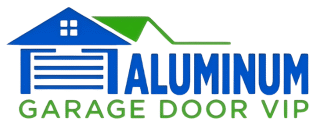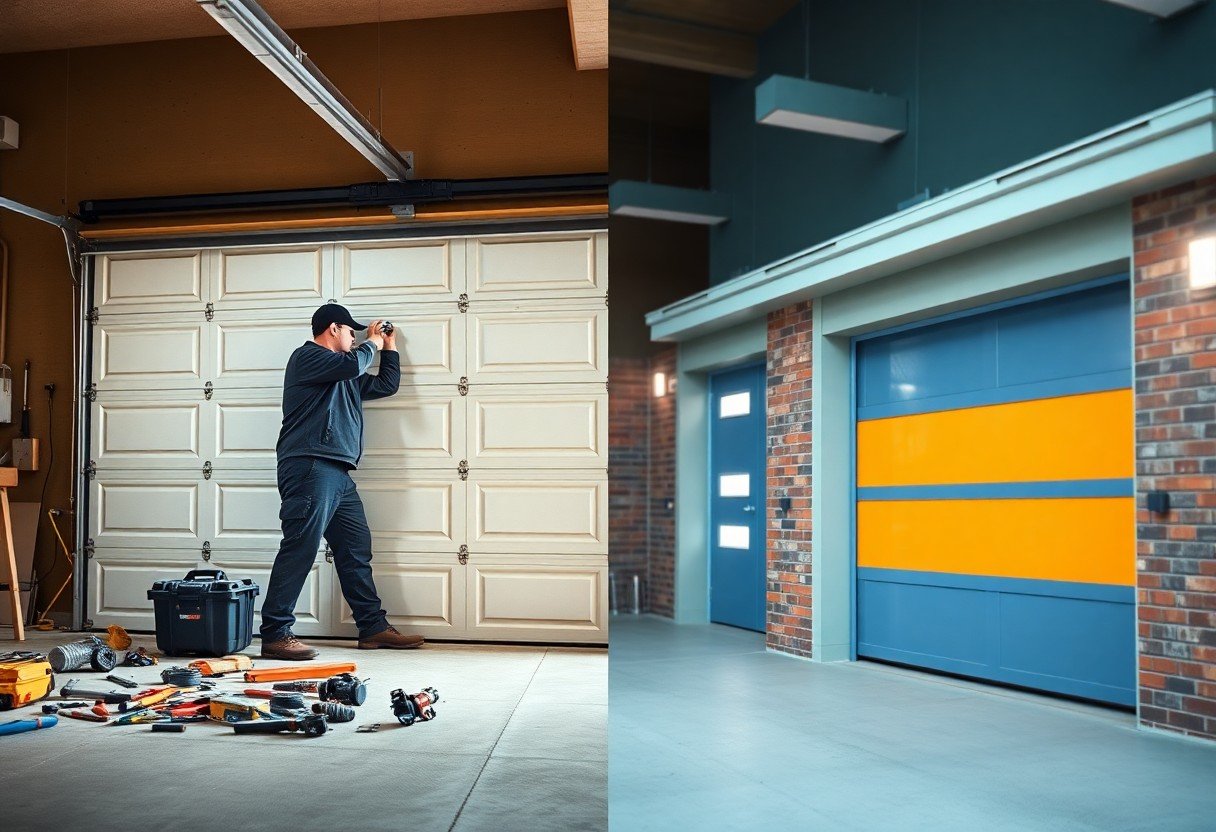
Garage Door Repair or Replacement? How to Decide
Most homeowners face the dilemma of whether to repair or replace their garage doors at some point. Understanding the signs of damage and the costs involved can help you make an informed decision. In this post, you’ll discover key factors to consider, from the extent of the damage to your budget and personal preferences. By assessing these elements, you can determine the best course of action for your garage door, ensuring safety and functionality in your home.
Key Takeaways:
- Assess the extent of the damage: A thorough inspection can help determine if a simple repair will suffice or if a full replacement is necessary.
- Consider the age of the garage door: Older doors may have outdated mechanics which can lead to higher long-term maintenance costs, making replacement a more viable option.
- Evaluate cost vs. benefit: Weigh the costs of repairs against the price of a new door, factoring in energy efficiency and potential increase in property value.
The Anatomy of a Garage Door Failure
Common Signs Your Garage Door Needs Repair
Experiencing difficulty with your garage door can often manifest in several ways. Listen for unusual sounds such as grinding or squeaking when opening and closing the door, or watch for signs like the door not fully closing or opening unevenly. You may also notice that it moves more slowly than usual or that the remote control fails to respond. These signs indicate that your door likely requires immediate attention to prevent further damage.
Assessing the Severity of Your Garage Door Issues
Determining the severity of your garage door problems involves evaluating both the symptoms you’re observing and the underlying mechanics at play. Simple issues, like worn-out springs or misaligned tracks, may lead to minor inconvenience, while more complex problems, such as a malfunctioning opener or significant structural damage, could represent a safety hazard and require urgent repair or even replacement.
Look closely at the specifics of your situation. For instance, if your garage door opens but doesn’t respond to the remote, electrical issues may be at fault, which are typically easier to fix. However, if you notice visible warping, strong vibrations during operation, or significant gaps when closed, there could be more serious issues at stake. Consider the age of your garage door too; many models have a lifespan of around 15 to 30 years, and if yours is nearing that mark with persistent problems, replacement might be the wiser choice.
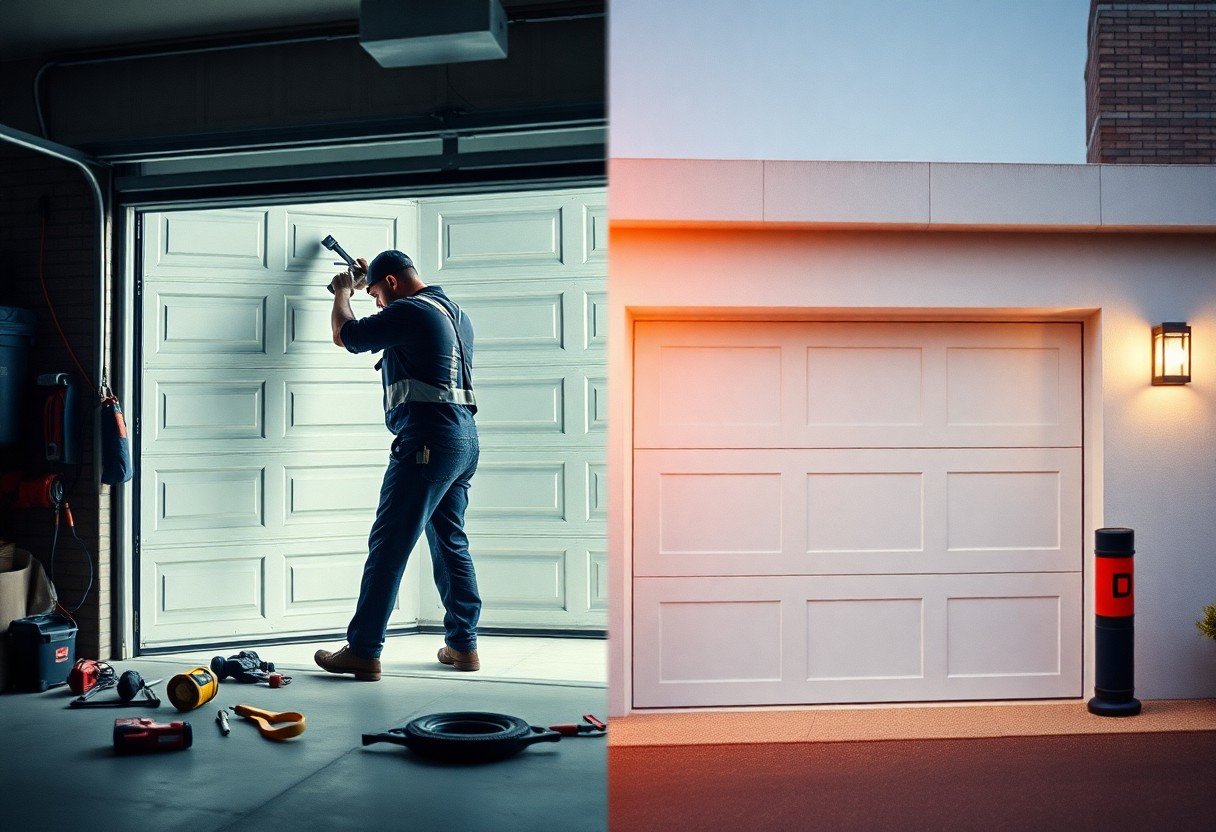
Cost Considerations: Repair vs. Replacement
Breakdown of Repair Costs: What to Expect
Repair costs for garage doors typically range from $100 to $300, depending on the issue. Minor problems, such as replacing springs or repairing cables, can be on the lower end, whereas more extensive issues involving motor malfunctions or structural damage may climb higher. Be prepared for additional charges if you require a service call or if parts need to be ordered, which can add to your final bill. Obtaining quotes from multiple technicians can also help you find a fair price for the necessary repairs.
Long-Term Financial Implications of Replacement
Transitioning to a new garage door often involves higher upfront costs, averaging between $800 to $2,500 depending on the type and materials chosen. However, these expenses should be weighed against long-term benefits such as increased property value, enhanced energy efficiency, and reduced maintenance costs. Investing in a more durable and reliable system can yield savings over time, especially when considering potential repair costs you may incur with an older door.
Moreover, newer garage doors often come equipped with advanced features that can lead to improved functionality and energy savings. For instance, insulated doors significantly reduce heating and cooling costs. Over time, the enhanced convenience and security offered by newer models can also lead to savings, making the initial investment in replacement worth it in the long run. You may also qualify for warranties that cover repairs or parts, further mitigating future costs and providing peace of mind.
The Lifespan Factor: How Age Influences Your Decision
Understanding Garage Door Lifespan Expectations
Your garage door has an average lifespan of 15 to 30 years, depending on the material and maintenance it receives. Steel doors tend to last longer than wooden ones, which may require more upkeep. The type of opener, wear and tear, and environmental factors can also impact longevity. When assessing your door, consider its age against these benchmarks to determine if a repair or replacement is the better option.
Age-Related Performance Degradation: What to Look For
As your garage door ages, certain signs indicate a decline in performance. Unusual noises, slow operation, and misalignment are common issues. Pay attention to any visible rust, loose parts, or damaged panels. If your door struggles to open or close, these symptoms could point to deeper problems, necessitating an evaluation of whether repairs or replacement would be more beneficial.
The wear on your garage door can manifest in ways that significantly impact its function. For example, an older door may require more frequent repairs, such as replacing springs or rollers, which can add to your long-term costs. Additionally, if your garage door is brand-specific, sourcing replacement parts for older models might become challenging, leading to longer downtimes during repairs. A consistent inspection for any sagging or gaps can help assess if its operational issues stem from age, prompting a more informed choice between repair and replacement.
Evaluating Safety: When Repairing May Compromise Security
The Role of Security Features in Modern Garage Doors
Modern garage doors come equipped with advanced security features, including rolling codes, encrypted signals, and smartphone monitoring. These innovations work to prevent unauthorized access, ensuring that your belongings remain safe. If your garage door has outdated technology or lacks these features, repairs may not be sufficient to secure your property, making replacement a more viable option for enhanced security.
The Risks of Deferring Repairs in an Old System
Delaying necessary repairs on an old garage door system can increase vulnerability to break-ins and accidents. Components may wear down unpredictably, leading to complete system failures at inconvenient times. Failures can also create unsafe conditions, posing risks not just to personal property but also to the safety of your family and anyone using the garage.
Old garage door systems often lack the safety redundancies and improved materials found in newer models. For instance, older doors may have a single-point locking system that can be easily compromised, while newer designs feature multi-point locking and reinforced tracks. Neglecting these repairs may lead to bigger issues, both financially and in terms of personal safety, as the risk of break-ins rises with every day an outdated system remains in service.
Aesthetic Appeal: How Curb Appeal Affects Your Home Value
The Visual Impact of Garage Door Styles
Your garage door accounts for a significant portion of your home’s façade, making its style integral to your overall curb appeal. Different styles — from sleek, modern doors to classic carriage house designs — evoke distinct feelings and complement various architectural designs. Choosing a garage door that aligns with your home’s aesthetic can instantly elevate its appearance, making it more inviting and increasing your chances of attracting potential buyers. It’s an opportunity to express your taste and can set the tone for your entire property.
Enhancing Property Value Through Replacement
Opting for a new garage door can add substantial value to your home. Research indicates that a garage door replacement can yield a return on investment (ROI) of over 90%, making it one of the most cost-effective home improvements. In neighborhoods where curb appeal drives property values, a stylish, functioning garage door becomes a focal point that could influence buyers’ perceptions and desirability. The advantage doesn’t just stop at aesthetics — you may also benefit from increased energy efficiency and reduced maintenance costs.
Furthermore, enhancements in materials and technology can improve your home’s security and convenience. States such as Utah and Colorado have experienced a heightened demand for durable, insulated garage doors that not only improve energy efficiency but also provide better protection against harsh weather conditions. You’ll find that potential buyers are willing to pay a premium for features like smart home capabilities, improved insulation, and a visually appealing design. According to several studies, investing in a new garage door not only makes your home more attractive but also significantly boosts its market value. If you’re contemplating your options, consider reading about Should I Repair The Old Garage Door Or Buy A New One? for additional insights on how to approach your decision.
Your DIY Options: When to Take on the Task Yourself
Basic Repairs You Can Handle Independently
Many minor garage door issues can be tackled without professional help, saving you time and money. Simple tasks like lubricating hinges, checking the alignment of tracks, and tightening screws or bolts can enhance performance and prolong the life of the door. You may also handle replacing worn weather stripping or even changing the batteries in your remote control. Keeping these components in good condition ensures that your door operates smoothly and efficiently.
Knowing When It’s Time to Call the Professionals
Complex repairs requiring specialized knowledge or tools are often best left to trained technicians. Problems like a misaligned torsion spring, a broken cable, or electrical failures indicate that the issue is beyond basic maintenance. If you’re unsure about your skill level or if safety is a concern, seeking professional assistance becomes necessary. Ignoring a serious problem can lead to costly damage, so acting swiftly when you sense a more significant malfunction is key.
Consider the potential risks associated with certain repairs. For instance, torsion springs are under immense pressure and can cause injury if handled incorrectly. Most repair services also offer warranties or guarantees, providing peace of mind that the job has been done right. Investing in professional help may save you from future headaches, ensuring your garage door operates safely and reliably for years to come.
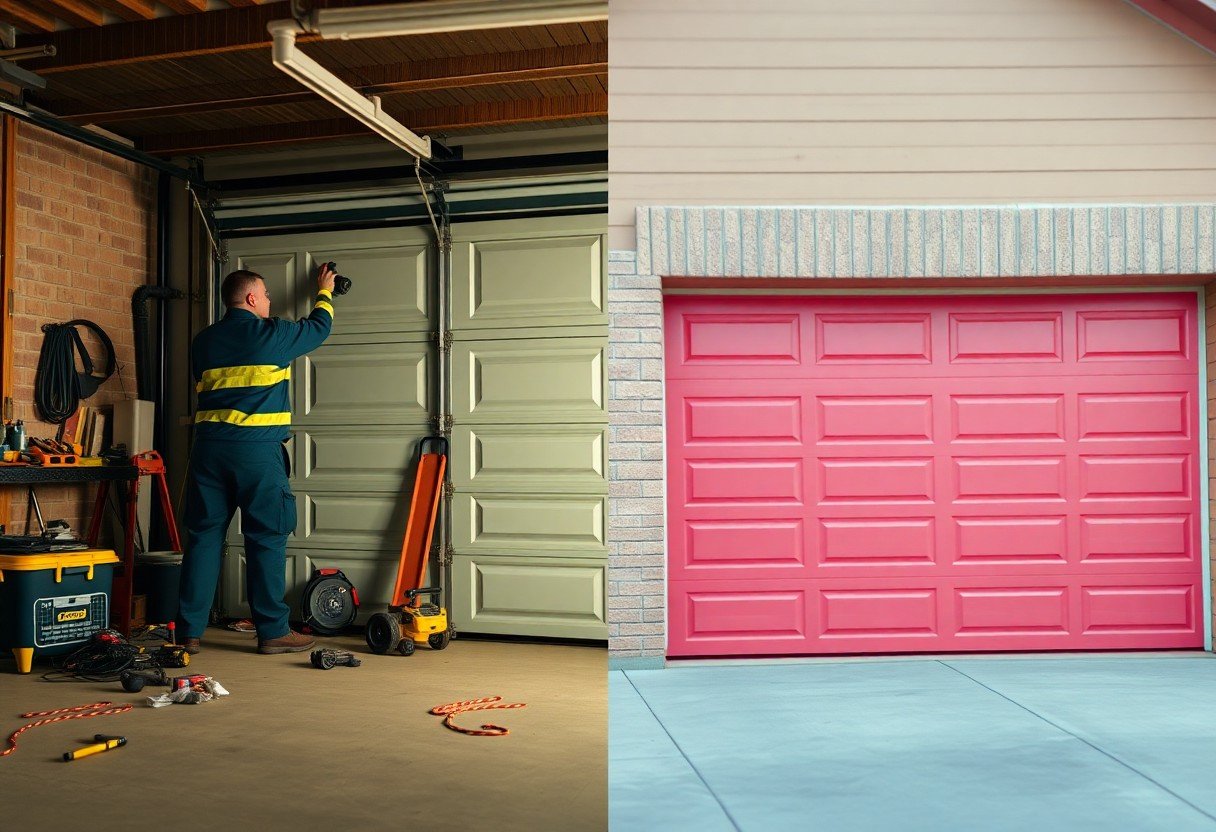
Environmental Considerations: Energy Efficiency and Sustainability
Comparing Energy Efficiency Ratings in Garage Doors
Understanding energy efficiency ratings is crucial for making an informed decision about your garage door. Different materials and designs lead to varied levels of insulation and energy conservation. Below is a comparison of popular garage door materials based on their efficiency ratings:
| Material Type | Average R-Value |
|---|---|
| Steel | 6-8 |
| Wood | 3-5 |
| Fiberglass | 7-10 |
| Vinyl | 5-7 |
Choosing Eco-Friendly Materials in New Installations
Opting for eco-friendly materials during your garage door installation not only supports sustainability but also benefits your home’s energy efficiency. Materials such as recycled steel or sustainably sourced wood significantly reduce environmental impact. Additionally, many manufacturers offer insulated doors made from eco-conscious materials that enhance thermal performance, helping you save on energy bills.
Choosing eco-friendly materials involves considering the lifecycle of the products, their source, and their long-term efficiency. For example, steel doors produced from recycled materials result in lower energy consumption and waste. Furthermore, look for doors with certifications like ENERGY STAR, which indicate they meet stringent energy efficiency standards. By investing in a garage door made with sustainable options, you not only enhance your home’s functionality but also contribute to a healthier planet for future generations.
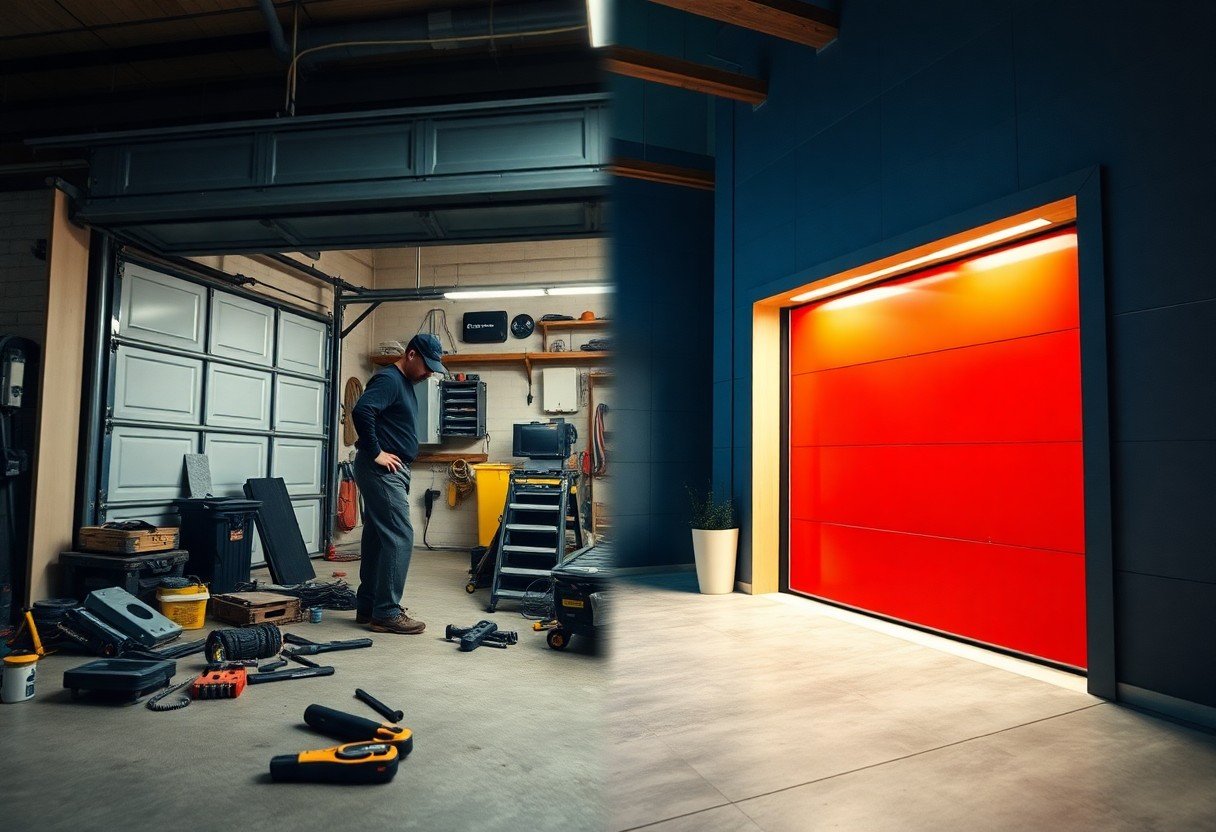
The Decision-Making Process: Crafting Your Game Plan
Creating a Pros and Cons List for Repair vs. Replacement
Weighing the benefits and drawbacks of repairing or replacing your garage door can clarify your decision. A pros and cons list is a straightforward way to assess your options effectively. Here’s a breakdown to consider:
| Repairs | Replacement |
|---|---|
| Generally lower immediate costs | Can provide long-term reliability |
| Can extend the life of your current door | Increased energy efficiency |
| Less disruption to your routine | Enhances curb appeal and home value |
| Convenient for minor issues | Offers modern features (smart technology) |
| Less complex decision-making | Possible warranties on new doors |
| May not solve underlying problems | Higher upfront investment |
| Temporary fix may lead to future costs | Requires time for installation |
| Limited in terms of design options | Potentially better durability |
| May require repeat repairs | Could increase property resale value |
| Risk of not addressing safety issues | Opportunity to customize (style, color) |
Consulting with Experts: Questions to Ask
When you’re considering your options, reaching out to professionals can provide valuable insights. Prepare a list of targeted questions, such as, “How long can I realistically expect my current garage door to last with repairs?” or “What is the total cost difference between repairing and replacing?” Solid information from experts will guide your decision process and can help you uncover details you might have otherwise overlooked.
Take advantage of the expertise available to you. Consulting with professionals allows you to obtain tailored advice specific to your garage door’s condition and age. Ask about the latest technologies available in new garage doors and how they can benefit your home. You may also want to inquire about warranties and maintenance plans for both options. Getting clarity on these factors can be important in making a well-informed decision. For more in-depth insights, check out this resource on When Should I Replace My Garage Door?.
Final Words
The decision between garage door repair or replacement ultimately hinges on various factors, including the extent of damage, your budget, and the lifespan of your current door. Assess whether the repairs provide a long-term solution or if investing in a new door might better serve your needs. Consider the added benefits of a new model, such as enhanced security and energy efficiency. By weighing these elements, you can make an informed choice that aligns with your preferences and your home’s requirements.
FAQ
Q: How can I determine if my garage door needs repair or replacement?
A: Assessing whether to repair or replace your garage door involves examining its age, condition, and functionality. If your door is more than 15-20 years old and exhibits significant wear and tear such as rust, dents, or inability to open and close smoothly, replacement might be the best option. Conversely, if it shows minor issues like a broken spring or misaligned tracks, repairs may suffice. Additionally, consider insulation and energy efficiency; an outdated door may not provide the necessary insulation and could increase energy costs.
Q: What are the typical repair issues that can be fixed, and how do they compare to replacement costs?
A: Common repair issues include broken springs, damaged cables, misaligned tracks, or malfunctioning openers. Repair costs usually range from $150 to $500, depending on the issue and parts needed. In contrast, a complete replacement can cost anywhere from $800 to $2,500 or more, depending on the material, design, and installation. It’s advisable to get a cost estimate for both options and evaluate your budget and preferences before making a decision.
Q: How do I consider the long-term benefits of repairing versus replacing my garage door?
A: Long-term benefits hinge on factors such as durability, security, and energy efficiency. A new garage door can improve your home’s curb appeal, increase property value, and offer better insulation, leading to reduced energy bills. On the other hand, repairs can be a cost-effective solution if the door is still relatively new and in good shape. Consider how long you plan to stay in your home and the potential for increased value versus the risk of needing future repairs. Consulting a professional can help you weigh the long-term benefits effectively.
